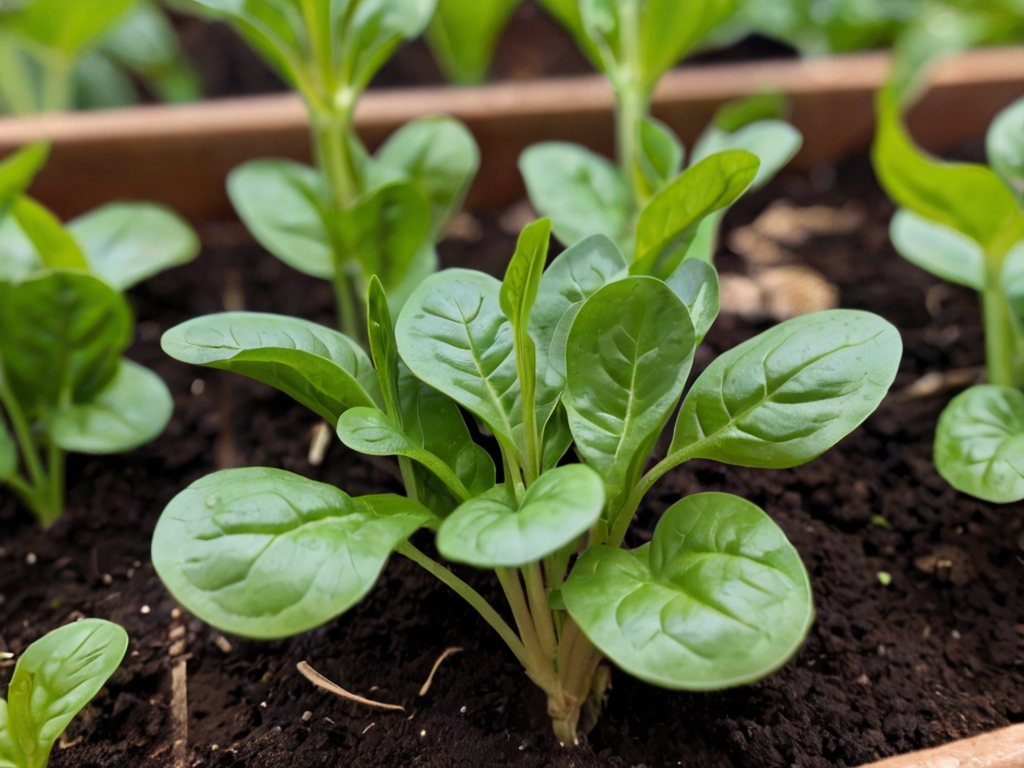Companion planting is essential for spinach growth and yield for several reasons. First, certain companion plants can help improve soil health by adding nutrients, increasing organic matter, and improving soil structure.
This is particularly important for spinach, as it is a heavy feeder that requires nutrient-rich soil to grow well.
- The Benefits of Growing Spinach Companion Plants: Improved Soil Health and Pest Control
- Best Spinach Companion Plants for Small Gardens: Herbs and Flowers
- How to Plant Spinach Companion Plants: Tips for Optimal Growth and Yield
- The Role of Nitrogen-Fixing Plants in Spinach Companion Planting
- Companion Plants for Spinach in Containers: Ideal Choices for Limited Space
- Spinach Companion Plants for Pest Control: Natural Solutions to Common Garden Pests
- Edible Spinach Companion Plants: Adding Flavor and Nutrition to Your Garden
- Spinach Companion Plants for Seasonal Planting: Choosing the Right Plants for Your Climate
- Maximizing the Benefits of Spinach Companion Planting for a Thriving Garden
Second, companion plants can help control pests naturally by attracting beneficial insects that prey on common garden pests. This reduces the need for chemical pesticides, making it a more sustainable and environmentally friendly approach to pest control. Growing spinach companion plants can help create a healthier and more productive garden.
The Benefits of Growing Spinach Companion Plants: Improved Soil Health and Pest Control

One key benefit of growing spinach companion plants is improved soil health. Certain plants, known as “green manures,” can be grown alongside spinach to add nutrients to the soil. For example, legumes such as clover or vetch are nitrogen-fixing plants that can convert atmospheric nitrogen into a form that can be used by plants. When these legumes are grown as companion plants for spinach, they can help increase the nitrogen content in the soil, which is essential for healthy plant growth.
In addition to improving soil health, companion plants can also help control pests naturally. Many common garden pests have natural predators that can be attracted to the garden by planting specific companion plants. For example, planting flowers such as marigolds or calendula can attract beneficial insects like ladybugs and lacewings, which feed on aphids and other pests. By attracting these natural predators, companion plants can help keep pest populations in check without the need for chemical pesticides.
Best Spinach Companion Plants for Small Gardens: Herbs and Flowers
For gardeners with limited space, herbs and flowers make excellent spinach companion plants. These plants not only benefit spinach growth but also add beauty and fragrance to the garden. Some of the best herbs to grow alongside spinach include basil, dill, and parsley. These herbs not only repel pests like aphids and spider mites but also enhance the flavour of spinach when used in cooking.
Flowers such as marigolds, nasturtiums, and calendula are also excellent choices for small gardens. These flowers attract beneficial insects that prey on common garden pests, making them excellent natural pest control companions for spinach. Additionally, their vibrant colours can add visual interest to the garden and attract pollinators like bees and butterflies.
How to Plant Spinach Companion Plants: Tips for Optimal Growth and Yield
When planting spinach companion plants, it is essential to consider their growth habits and spacing requirements. Here is a step-by-step guide to planting spinach companion plants:
1. Choose companion plants that have similar growing requirements to spinach. This will ensure that they thrive together in the same garden bed.
2. Prepare the soil by removing weeds or debris and loosening it with a garden fork or tiller. Add compost or organic matter to improve soil fertility.
3. Plant the spinach seeds or seedlings according to their spacing requirements. Spinach typically requires about 6-8 inches of spacing between plants.
4. Plant the companion plants around the spinach, leaving enough space to grow without overcrowding each other.
5. Water the plants thoroughly after planting and continue to water regularly, keeping the soil evenly moist.
6. Mulch the garden bed to help conserve moisture, suppress weeds, and improve soil health.
7. Monitor the plants for any signs of pests or diseases and take appropriate action if necessary.
By following these tips, you can ensure optimal growth and yield for spinach and its companion plants.
The Role of Nitrogen-Fixing Plants in Spinach Companion Planting
Nitrogen-fixing plants play a crucial role in spinach companion planting. These plants can convert atmospheric nitrogen into a form other plants can use. This is important for spinach, as it is a heavy feeder that requires a steady nitrogen supply to grow well.
Some of the best nitrogen-fixing plants to grow alongside spinach include legumes such as clover, vetch, and peas. These plants have specialized root nodules that contain bacteria called rhizobia. These bacteria have a symbiotic relationship with the legumes, providing them with nitrogen in exchange for carbohydrates produced by the plants through photosynthesis.
When these nitrogen-fixing plants are grown as companion plants for spinach, they can help increase the nitrogen content in the soil. This can improve the overall health and productivity of the spinach plants, leading to better growth and higher yields.
Companion Plants for Spinach in Containers: Ideal Choices for Limited Space
Growing spinach and its companion plants in containers is an excellent option for gardeners with limited space. Many herbs and flowers that make good spinach companion plants can be grown successfully in containers. Here are some ideal choices for container gardening:
1. Basil: This herb not only repels pests but also enhances the flavour of spinach when used in cooking. It can be grown in a small pot or container on a sunny balcony or patio.
2. Marigolds: These flowers attract beneficial insects that prey on common garden pests. They can be grown in pots or hanging baskets to add colour and beauty to the garden.
3. Nasturtiums: These flowers attract beneficial insects and deter pests like aphids and whiteflies. They can be grown in hanging baskets or trailing over the edges of containers.
When growing spinach and its companion plants in containers, it is essential to choose large enough containers to accommodate both plants’ root systems. Use a well-draining potting mix and water regularly to keep the soil evenly moist. Place the containers in a sunny location and support climbing plants if necessary.
Spinach Companion Plants for Pest Control: Natural Solutions to Common Garden Pests
Companion plants can play a crucial role in controlling common garden pests naturally. By attracting beneficial insects that prey on pests, these plants can help keep pest populations in check without the need for chemical pesticides. Here are some companion plants that are known for their pest-control properties:
1. Marigolds: These flowers emit a strong scent that repels many pests, including aphids, nematodes, and whiteflies. They also attract beneficial insects like ladybugs and lacewings, which feed on these pests.
2. Nasturtiums: These flowers repel pests like aphids and whiteflies and attract predatory insects like hoverflies and parasitic wasps, which feed on them.
3. Chives: This herb repels pests like aphids, carrot flies, and Japanese beetles. It also attracts beneficial insects like bees and butterflies, which help with pollination.
By planting these companion plants alongside spinach, you can create a natural pest control system that reduces the need for chemical pesticides.
Edible Spinach Companion Plants: Adding Flavor and Nutrition to Your Garden
In addition to their benefits for spinach growth, some companion plants can be harvested and eaten, adding flavour and nutrition to your garden. Here are some edible companion plants that can be grown alongside spinach:
1. Herbs: Basil, dill, parsley, and cilantro are all herbs that make good spinach companion plants and can be harvested for culinary use. They enhance the flavour of spinach and provide their unique flavours and aromas to dishes.
2. Edible Flowers: Flowers such as nasturtiums, calendula, and borage are beautiful and edible. They can garnish salads or add colour and flavour to various dishes.
3. Lettuce: Certain lettuce varieties, such as loose-leaf or mesclun mix, can be grown alongside spinach and harvested for salads or sandwiches.
By incorporating these edible companion plants into your garden, you can create a diverse and flavorful harvest.
Spinach Companion Plants for Seasonal Planting: Choosing the Right Plants for Your Climate
When choosing spinach companion plants, it is essential to consider the climate and growing season in your area. Different plants have different temperature and sunlight requirements, so choosing companion plants suitable for your climate is essential. Here are some companion plants that are suitable for different climates:
1. Cool-Season Companion Plants: In cooler climates with shorter growing seasons, cool-season crops like lettuce, radishes, and peas make good companions for spinach. These plants can be planted alongside spinach in early spring or late summer for a bountiful harvest.
2. Warm-Season Companion Plants: In warmer climates with longer growing seasons, warm-season crops like tomatoes, peppers, and cucumbers can be grown alongside spinach. These plants thrive in the heat and can provide shade and support for the spinach plants.
3. Mediterranean Companion Plants: In Mediterranean climates with mild winters and hot summers, herbs like rosemary, thyme, and oregano make excellent companions for spinach. These herbs are well-suited to the dry and sunny conditions of the Mediterranean region.
By choosing companion plants suitable for your climate, you can ensure they thrive alongside spinach and contribute to a successful harvest.
Maximizing the Benefits of Spinach Companion Planting for a Thriving Garden
In conclusion, spinach companion plants play a crucial role in maximizing the growth and yield of spinach. By choosing the right companion plants, gardeners can improve soil health, control pests naturally, and add flavour and nutrition to their gardens. Whether you have a small garden or limited container gardening space, companion plants can benefit your spinach plants. Following the tips and suggestions outlined in this article, you can create a harmonious and thriving garden ecosystem that will reward you with a bountiful harvest of spinach and its companion plants.

